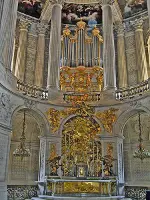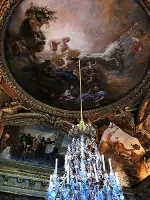The Opulent Glory of Versailles
Part 2: Absolute Opulence
The new French government took over the running of Versailles and, in 1792, sold off much of the furniture that filled the many dozen rooms of the royal palace and carted off many of the artworks for display at the Louvre. The strongest hand to rise out of the ashes of the Revolution, Napoleon Bonaparte, ordered some restoration work done at Versailles, and this was continued by the restored monarch, Louis XVIII. 
King Louis-Philippe decreed that Versailles would be a museum of French history, and this was done in 1837. Among the well-known elements of Versailles are these:

The royal palace played host to many international conferences, including the signing of the Treaty of Paris that ended the American Revolutionary War and the signing of the Treaty of Versailles (left) that ended World War I. (In a reversal of fortune for France, the victorious Kaiser Wilhelm II had himself proclaimed Emperor of Germany in the Hall of Mirrors after his country won the Franco-Prussian War.) In more recent times, money has been found for restoration of parts of Versailles damaged in the 1789 uprising. The palace and grounds, now a UNESCO World Heritage Site, remain a very popular tourist attraction to this day, with annual visits regularly topping 3 million. The palace is so large, however, that only a fraction of the rooms are open to the public. |
|
Social Studies for Kids
copyright 2002–2025
David White



 Things got so bad that in 1788, the French government ran out of money entirely and the king was forced to summon the Estates-General, a sort of Parliament that hadn't met in nearly two centuries. Things went from very bad to very much worse for king, queen, and aristocracy, as a mob stormed the Bastille and another mob stormed Versailles, demanding food and other riches that were in short supply out in the world. The French Revolution had begun.
Things got so bad that in 1788, the French government ran out of money entirely and the king was forced to summon the Estates-General, a sort of Parliament that hadn't met in nearly two centuries. Things went from very bad to very much worse for king, queen, and aristocracy, as a mob stormed the Bastille and another mob stormed Versailles, demanding food and other riches that were in short supply out in the world. The French Revolution had begun. The Ambassador's Staircase
The Ambassador's Staircase
